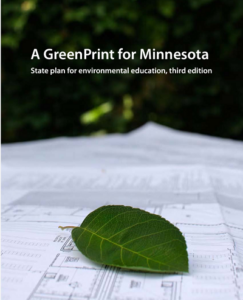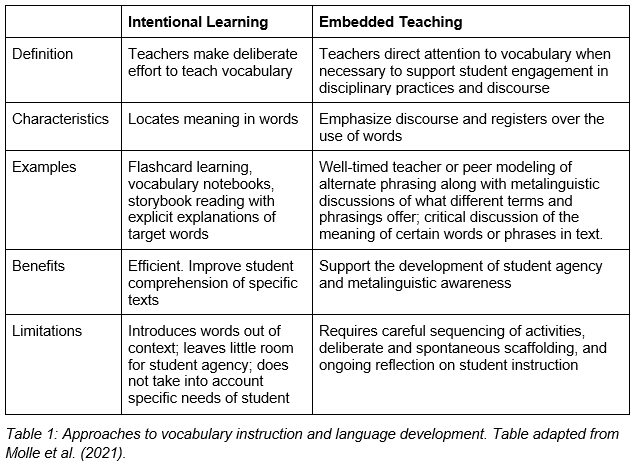- MN ABE Connect
- Archive
- Embedded Teaching: A Socio-Cultural Approach to Language Learning Through Science
 January 29, 2024
January 29, 2024
Embedded Teaching: A Socio-Cultural Approach to Language Learning Through Science
Lucas Rapisarda, Program Director In 2022, the Minnesota legislature ratified statute 115A.073, which states that all residents of Minnesota should, “a) Be able to apply informed decision-making processes to maintain a sustainable lifestyle; and b) have access to information and experiences needed to make informed decisions about actions to take on environmental issues”.
In 2022, the Minnesota legislature ratified statute 115A.073, which states that all residents of Minnesota should, “a) Be able to apply informed decision-making processes to maintain a sustainable lifestyle; and b) have access to information and experiences needed to make informed decisions about actions to take on environmental issues”.
To achieve the goals of this statute, the state published the “Greenprint for Minnesota: A state plan for environmental education”, which provides a blueprint for Minnesotans of all ages to have access to quality, equitable environmental education.
Science and ABE standards
How can ABE classrooms in Minnesota meet these goals? The College and Career Readiness Standards cover content in the areas of English language arts, literacy, and mathematics, but do not have any content standards related to science or environmental education.
Although standards do exist for reading scientific and technical text, as well as writing for scientific and technical subjects, there are no requirements or guidelines for what to read and write about. This becomes an even more interesting question when considered within the context of adult English language (EL) learners, many of whom are not originally from Minnesota and thus may need additional support to interpret place-based environmental issues.
Additional challenges for EL learners
One place that ABE classrooms can meet this goal is through the science classroom, where many issues of the environment and sustainability are frequently discussed. However, the science classroom comes with its own challenges for adult learners.
 For starters, it is infamous for its use of complex, content-specific words that often borrow terms from everyday English: cultures, galls, and moles all mean different things to microbiologists, botanists, and chemists, let alone the average newcomer to the language. Science classrooms consist of a variety of language registers – the social usage of particular words and expressions that mean different things in different contexts. Many EL learners arrive in classrooms with knowledge of colloquial/social language registers that they use on a daily basis to communicate with their peers, but lack the ‘academic’ and ‘disciplinary’ registers of the science classroom.
For starters, it is infamous for its use of complex, content-specific words that often borrow terms from everyday English: cultures, galls, and moles all mean different things to microbiologists, botanists, and chemists, let alone the average newcomer to the language. Science classrooms consist of a variety of language registers – the social usage of particular words and expressions that mean different things in different contexts. Many EL learners arrive in classrooms with knowledge of colloquial/social language registers that they use on a daily basis to communicate with their peers, but lack the ‘academic’ and ‘disciplinary’ registers of the science classroom.
Embedded teaching vs. intentional learning
To address this issue, many researchers recommend embracing the interconnectedness of language learning and science. In other words, they emphasize the learning of academic and disciplinary language through content as opposed to learning this language parallel or prior to content.
One such teaching pedagogy that adheres to this mindset is called embedded teaching. This approach builds on existing student knowledge by relying on sense-making activities that use informal, collaborative meaning-making with peers to understand concepts, and shifting these conversations into more formal registers over time.
This approach, which is described in the TESOL journal, discourages what the authors describe as ‘intentional learning’ of vocabulary and instead leverages incidental learning of vocabulary through experiential learning opportunities in the classroom. As students ‘make sense’ of new ideas, educators can incorporate academic and disciplinary vocabulary to help students explain an experience or phenomenon. Unlike intentional learning, embedded teaching emphasizes discourses and registers over the use of specific words, which supports the development of student agency. While the authors point out that intentional learning can be more efficient and helps expand student vocabulary, it often introduces words out of context.
Table 1 below illustrates the difference between these two approaches.
So what exactly does all of this mean for MN Adult Ed teachers?
Nature for New Minnesotans (NFNM) is a University of Minnesota extension program that is committed to developing lessons for adult EL students that promote embedded teaching practices. The program, which began in the fall of 2021, is developing modules that focus on the natural history of Minnesota and many of its outdoor activities. In particular, it seeks to provide adult EL learners with information on Minnesota’s natural environment and how to engage with it sustainably.
Each module contains relevant vocabulary, leveled readings, hands-on activities, and recommended extension activities. Additionally, each module contains a lesson sequence that culminates in a series of outdoor experiences. While these modules were originally designed for intermediate and advanced EL students, they can be adapted for classrooms based on English understanding.
Additionally, many of the topics discussed in these modules are found regularly in the science GED reading section.
Check out Part 2!
In Part 2 of this article, we dive deeper into one of these lessons and highlight the areas that promote embedded teaching.
References
Kennedy, M.J., Stromme, D.M. (2008). A GreenPrint for Minnesota: State plan for environmental education, third edition. Minnesota Pollution Control Agency. https://www.leg.mn.gov/docs/2009/other/090734.pdf
Molle, D. DeOliveira, L.C., MacDonald, R. Bhasin, A. (2021). Leveraging incidental and intentional vocabulary learning to support multilingual student’ participation in disciplinary practices and discourses. TESOL Journal, 12:4. https://doi-org.ezp1.lib.umn.edu/10.1002/tesj.616
Newsletter Signup
Get MN ABE Connect—the official source for ABE events, activities, and resources!
Sign UpArticle Categories
- ABE Foundations/Staff Onboarding
- ACES/Transitions
- Adult Career Pathways
- Assessment
- CCR Standards
- Citizenship
- COVID-19
- Cultural Competency
- Digital Literacy/Northstar
- Disabilities
- Distance Learning/Education
- ELA
- Equity/Inclusion
- ESL
- HSE/Adult Diploma
- Listening
- Math/Numeracy
- Mental Health
- Minnesota ABE
- One-Room Schoolhouse/Multilevel
- Professional Development
- Program Management
- Reading
- Remote Instruction
- Science
- Social Studies
- Speaking/Conversation
- Support Services
- Teaching Strategies
- Technology
- Uncategorized
- Volunteers/Tutors
- Writing
